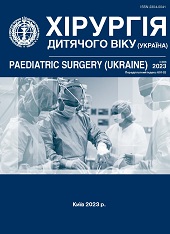Clinical and potentiometric examinations of adolescent patients with chronic odontogenic maxillary sinusitis in the presence of galvanic pathology in the oral cavity
DOI:
https://doi.org/10.15574/PS.2023.80.35Keywords:
chronic maxillary sinusitis, maxillary sinus, galvanic pathology, potentiometry, galvanism, galvanosis, metal inclusionsAbstract
Purpose - to determine the values of potentiometric parameters in the oral cavity present between metal inclusions, as well as between metal inclusions and the mucous membrane of the alveolar ridge in adolescent patients with chronic odontogenic maxillary sinusitis in the presence of galvanic pathology in the oral cavity
Materials and methods. 30 patients with chronic odontogenic maxillary which were subjected to potentiometric and general clinical examination methods. The control group consisted of 22 practically healthy people (without concomitant diseases) of the same age, but without metal inclusions in the oral cavity (amalgam fillings and metal fixed dentures) with obligatory sanitized oral cavity.
All numerical data obtained during the survey were processed by mathematical method with calculation of Student's criterion. The indicators were considered reliable at p<0.05.
Results. In 30 patients with chronic odontogenic maxillary sinusitis with the presence of galvanism (compensated and decompensated forms) in the oral cavity, chronic inflammation in the maxillary sinus occurred without pronounced clinical symptoms.
Conclusions. In adolescent patients with chronic odontogenic maxillary sinusitis with the presence of galvanism in the oral cavity (compensated and decompensated forms), chronic inflammation in the maxillary sinus occurred without pronounced clinical symptoms. Exacerbation of the inflammatory process was rare. Among the inflammatory complications in the postoperative period, we found only gingivitis in the oral cavity. We did not observe any other inflammatory complications in the area of the postoperative soft tissues of the postoperative wounds and recurrence of inflammatory disease of the maxillary sinus.
The research was carried out in accordance with the principles of the Helsinki Declaration. The study protocol was approved by the Local Ethics Committee of participating institution. The informed consent of the patient was obtained for conducting the studies.
No conflict of interest was declared by the authors.
References
Tymofieiev OO. (2022). Shchelepno-lytsova khirurhiia. Kyiv: VSV "Medytsyna": 752.
Tymofieiev OO. (2012). Posibnyk z shchelepno-lytsevoi khirurhii ta khirurhichnoi stomatolohii. Vydannia 5-e (vypravlene i dopovnene). Kyiv: 1048.
Tymofieiev OO. (2020). Shchelepno-lytsova khirurhiia ta khirurhichna stomatolohiia. Pidruchnyk u 2 knyhakh. Knyha 1: 986.
Tymofieiev OO. (2022). Shchelepno-lytsova khirurhiia ta khirurhichna stomatolohiia. Pidruchnyk u 2 knyhakh. Knyha 2: 968.
Tymofieiev OO, Pavlenko OV, Tymofieiev OO. (2014). Halvanichna patolohiia v stomatolohii. Kyiv: TOV "Vydavnytstvo "Stal": 235.
Downloads
Published
Issue
Section
License
Copyright (c) 2023 Paediatric Surgery (Ukraine)

This work is licensed under a Creative Commons Attribution-NonCommercial 4.0 International License.
The policy of the Journal “PAEDIATRIC SURGERY. UKRAINE” is compatible with the vast majority of funders' of open access and self-archiving policies. The journal provides immediate open access route being convinced that everyone – not only scientists - can benefit from research results, and publishes articles exclusively under open access distribution, with a Creative Commons Attribution-Noncommercial 4.0 international license(СС BY-NC).
Authors transfer the copyright to the Journal “PAEDIATRIC SURGERY.UKRAINE” when the manuscript is accepted for publication. Authors declare that this manuscript has not been published nor is under simultaneous consideration for publication elsewhere. After publication, the articles become freely available on-line to the public.
Readers have the right to use, distribute, and reproduce articles in any medium, provided the articles and the journal are properly cited.
The use of published materials for commercial purposes is strongly prohibited.

